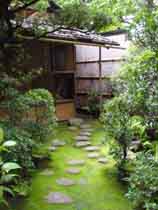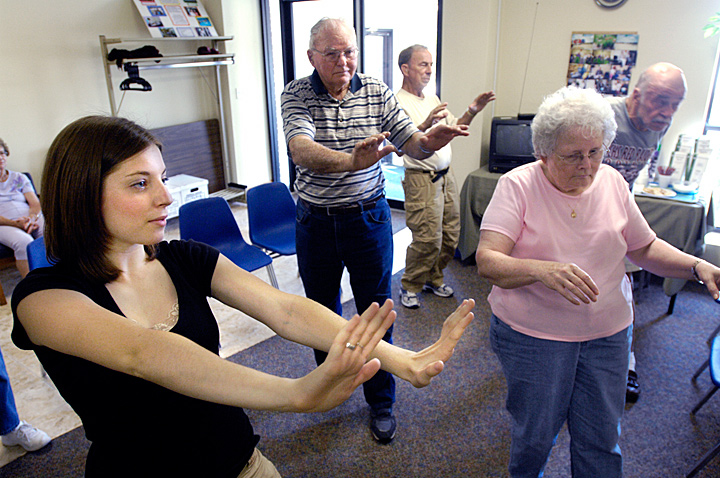
Is push-hands a fight to the death or an intimate bonding experience where you try to get your partner to blush?
That depends on what rule set you are using. The rule set you choose will be determined by your
view-- that
base or
root which orients you towards experience.
People whose primary orientation is
health, are often
worriers. Push-hands is just not self-centered enough for them. Put in a push-hands situation, they will be flimsy and blasé. They'll be thinking, "Why would I want to
puuuush you?"
People who see life as
a struggle will be looking for an advantage because "Baby, if you aren't on top, you're on the bottom!"
Nobody holds on to the same
view all the time, it would be too exhausting. I often teach push-hands from the
view that aggression is a
naturally occurring process which obscures subtlety. Aggression makes it more difficult to see or feel what is happening. At the same time, this
view is not a rejection of aggression, after all who wants to live in a world where everything is subtle? A world without sci-fi or punk rock? (OK, I know the answer, Buddhists right?)
So from this view, the rule set should be designed to bring out an aggressive intent which consistantly loses to a less aggressive intent. I know some of you are reading this and thinking, "Come on, how is that going to train killers?" or "How could we apply that idea to produce the worlds greatest fighter?"
Is it possible that the
weakest approach is destine to prevail? This is not about me claiming to know. It's about having fun
trying.
But let's return to the beginning and look at the question of how people determine their rule sets for push-hands.
I was one of several people teaching at a retreat and after class a guy wanted to push-hands with me. He was strong and thin, about 5 inches taller than me and about 30 lbs heavier. He had been practicing martial arts all his life. We agreed on fixed foot rules. As I filled in his empty spaces, he would duck and twist rather than lose his footing. This is what my students and I call, "losing your frame." If I want to win in such a situation (at least at the
jin level of practice) I have to apply either shoulder attack, elbow attack, or split. All three types of techniques could be considered an increase in aggression because they have a high probability of producing an injury in the opponent. Since I didn't want to hurt him, I didn't apply those techniques and I didn't win. But he really wanted to win and so after one of these duck-twists his stiff hand came up and hit me in the jaw chipping my tooth.
Afterwards he told me that he usually practices push-hands with a mouth piece. Later he told one of my students that all of his teeth were knocked out, he had
false teeth.
Over the years I've had many push-hands matches which I lost because I would not up the aggression when the other person did. In all cases, at the point in which we were playing by the same set of rules, I was winning, but as the rules changed I accepted the loss.
Kuo-lien Ying said, "You can't convince someone that martial arts works if they don't want to be convinced." They will always have a reason why that wasn't the "real thing."
When I'm teaching I give myself handicaps. I create rule sets which allow the student to win if they catch me being aggressive. For instance, rather than trying to sink below my student, I may sink my qi to exactly the level they are sinking to. I'll take out all the tricks I know and try to use the simplest clearest techniques. If I win, the student has a better chance of understanding why. If I lose, the student should be able to show where my defect was.
If my students start to win by aggression I'll change the rule set and my handicap so that they are always looking for
the less aggressive way to win. (People are often so in love with their aggressive strategies, they have so much fun losing, that it takes a long time to get them to
progress. )
Unfortunately you can't do that with a friendly challenger from another school, you have to work with whatever rule set you have in common and hope they don't try to change the rules halfway through.
Again, it is not that winning by aggression is bad, we are always winning by aggression even if that aggression is really really subtle.
What is the fruition of this practice? Is it a skill? Do you get really really good at it? The answer to those questions will depend on your
view (that which orients you towards experience).
Clearly a fruition for me has been that I have a choice about whether to react aggressively. That choice may have always been there, but I doubt I would have taken it if I hadn't done the practice. Another fruition is that I welcome aggression rather than rejecting it or attempting to flee it or dominate it. Students are free to explore aggression in my classes, if it comes up we play with it. And that's true in my daily life too.
Is that a skill? Am I good at it? The thing about push-hands is that the moment you kinesthetically understand a skill, it becomes a form of aggression--such that-- if you recognize that skill in your opponent, you can use it to defeat him/her. If you catch your opponent using a skill you understand, you can easily defeat them in push-hands.Â
So skill accumulation is not personal, you don't own it, it is something you are learning to recognize. A skill is something which will cause you to blush if you get caught using it. Like an old cheesy pick-up line you thought was original.


 You can't really be a "modern" person and not ask the questions with regard to pre-20th century ideas, "What should I keep and what should I discard?" "What can I use, and what will just hold me back?"
You can't really be a "modern" person and not ask the questions with regard to pre-20th century ideas, "What should I keep and what should I discard?" "What can I use, and what will just hold me back?"
 Is push-hands a fight to the death or an intimate bonding experience where you try to get your partner to blush?
Is push-hands a fight to the death or an intimate bonding experience where you try to get your partner to blush? "Nothing is ever a complete waste of time....
"Nothing is ever a complete waste of time.... otherwise boring situations. I had a "maintenance" job years ago which was a 6 hour day, but I could do the work in 3 hours so the rest of the time I just practiced my gongfu in a large storage locker looking out over the water. I kept a broom to lean on nearby in case anyone came looking for me. I also got arrested in an airport once because the airport was completely fogged in and I could think of nothing better to do than practice my forms.
otherwise boring situations. I had a "maintenance" job years ago which was a 6 hour day, but I could do the work in 3 hours so the rest of the time I just practiced my gongfu in a large storage locker looking out over the water. I kept a broom to lean on nearby in case anyone came looking for me. I also got arrested in an airport once because the airport was completely fogged in and I could think of nothing better to do than practice my forms.
 When Taijiquan was still new to Westerners, a few Masters claimed that the reason they had pot bellies was because they had so much qi.
When Taijiquan was still new to Westerners, a few Masters claimed that the reason they had pot bellies was because they had so much qi. I have a simple question for which I don't have a good answer.
I have a simple question for which I don't have a good answer.
 I saw David Mamet's new film,
I saw David Mamet's new film,  I've been reading Avron Albert Boretz's 1996 dissertation: Martial Gods and Magic Swords: The Ritual Production of Manhood in Taiwanese Popular Religion. I got it through Inter-Library Loan, but it looks like it can be
I've been reading Avron Albert Boretz's 1996 dissertation: Martial Gods and Magic Swords: The Ritual Production of Manhood in Taiwanese Popular Religion. I got it through Inter-Library Loan, but it looks like it can be 


 About 80% of the people I teach habitually slightly dislocate at least one of their hips. While they are young it hardly matters, young hips are juicy and forgiving. They just develop protective muscles which limit range of motion. But if one of these students takes a lot of weight in a slightly dislocated hip they can have pain. As people age the slight dislocation of the hips becomes a bigger and bigger problem.
About 80% of the people I teach habitually slightly dislocate at least one of their hips. While they are young it hardly matters, young hips are juicy and forgiving. They just develop protective muscles which limit range of motion. But if one of these students takes a lot of weight in a slightly dislocated hip they can have pain. As people age the slight dislocation of the hips becomes a bigger and bigger problem.
 Jade Maiden Works the Shuttles is the name of a taijiquan movement/posture. What does it mean?
Jade Maiden Works the Shuttles is the name of a taijiquan movement/posture. What does it mean? infinite time.
infinite time.